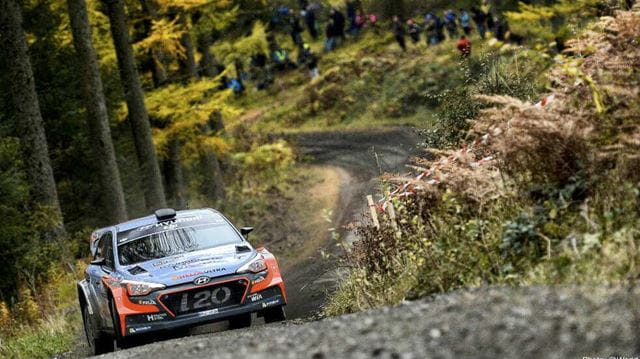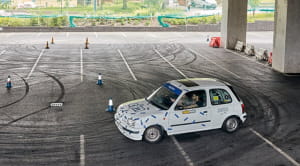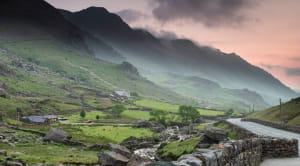
The mud, sweat and gears of the 2018 World Rally Championship will come to Wales in October. Here’s your spectator guide to one of motorsport’s most thrilling events
When you’re standing in the woods as cars tear through at 100mph, it won’t come as any surprise to learn that the Dayinsure Wales Rally GB ranks among Britain’s biggest live sporting attractions
Click here to download a map of the World Rally Championship in Wales
Now 86 years old and getting stronger by the season, much has changed since the inaugural 1932 Royal Automobile Club Rally, but the basics remain the same. Rallying is still motorsport in its most accessible and comprehensible form – taking a car from A to B faster than anybody else. But, today, the sport has never been faster, louder or more exciting – and Britain’s round of the World Rally Championship (4–7 October 2018) brings all that close to home.
As the Welsh forests play host to Rally GB once again, it’s well worth a trip. Prepare to be amazed – yes, you’re watching cars like a Ford Fiesta and a Hyundai i20 Coupe, but you’ve never seen them dance in the dirt like this before.

How it works
Formerly a round of the MSA British Rally Championship and held in towns as geographically diverse as Brighton and Blackpool, Wales Rally GB – as the name suggests – now resides largely on the western side of Offa’s Dyke. Deeside is home, and the rally village is based at Toyota’s 115-acre engine site.
This is where the cars stay overnight and it’s the only place where the teams can work on them. They can keep a certain number of spares in the car, but major component changes can only be carried out in the service park. The crews depart from here on each of the three main days of competition, heading out to complete a timetable of 23 stages – sections of road, track or pathway set mainly in the forests and ranging in length from a mile to 22 miles – in the fastest time possible. These tracks are closed to public traffic and essentially become a racetrack for the day.
The cars are set off one-by-one at two-minute intervals, and the winning crew will accumulate the least amount of time to get between the start and finish of those 23 stages. At no point do cars race against each other. You’ll only see two cars in one place when one or other of the cars has had a problem. In these competitive sections, the drivers will push as hard as they dare – off the start, the modern World Rally Car will be hitting 60mph in just a couple of seconds and it will double that speed in the fastest sections. A 120mph top speed might not sound huge, but try doing that down a dark, narrow, muddy, rutted forest track with trees for crash barriers – you and I wouldn’t dream of moving out of first gear.

A Wales rally plan
First things first: head to the Wales Rally GB website to buy your tickets. You can buy them on the day, but advance is cheaper. Talking of cheaper, the World Rally Pass at £99 is the best value – this gives you access to all the stages (including Thursday’s shakedown test – think of it as final practice) and even a dedicated car park at service in Deeside.
Thursday 4 October
Thursday night’s crowd-pleaser at the Tir Prince raceway in Towyn, just off the A55 is a great introduction. You’ll see the cars in full flight, but in a more spectator-friendly environment.
Friday 5 October
In a change to last year's schedule, the action on Friday moves to north Wales. The races take place in the forests of Brenig, Alwen and Penmachno, and sections of the roads will be closed for these new challenges. The cars will also race past Zip World at the Slate Caverns, with a new Slate Mountain double-header stage.
Saturday 6 October
The 'Super Saturday' stage features two British winning drivers, Elfyn Evans and Kris Meeke. The races take place around mid Wales, including the Sweet Lamb complex (so-called because the stage runs through one of Wales’ largest sheep farms) on the A44 just west of Llangurig. Heading towards Aberystwyth, follow the spectator signage to the right. Officials will guide you straight into your parking space close to the action. Naturally, you’ll face a longer walk the later you arrive stage-side. Set in a natural amphitheatre, Sweet Lamb offers some of the best rally watching in Britain. You’ll see the cars at speed, in hairpin bends, through a watersplash and flying through the air.
It also includes a bona fide Welsh rally legend: Dyfi (run at 10.28am and 4.45pm). Known and feared up and down the ages and all around the world, this section of forest has claimed some of the sport’s biggest names and will provide another massive challenge in October. Head west out of Shrewsbury and Welshpool and you’ll come to a village called Mallwyd – turn left or right on to the A470 and the road will take you to two different sections of Dyfi. Turning left towards Aberangell is the quickest, busiest car park on the east side of the stage. If you turned right at Mallwyd, then turn left on to the A487 at the Cross Foxes and head south. Whether you’re coming off the A470 or the A487, the car parks are well signed off the road. You’ll go into the heart of the woods and park in a long line at the side of the access road (it might be worth getting there earlier and turning your car around if you’re exiting the same way). The action in both sections is fast and spectacular. Get in early and have a good walk up and down the spectator area – you’ll find a wide variety of bends.
Sunday 7 October
In Snowdonia there are two forest tests on Sunday morning, and then the finale of the weekend takes place on the roads around Llandudno, which are closed for the event. After racing around the famous Great Orme headland, the cars finish on the seafront. The ceremony and prize-giving are on the promenade, from 12.30 on Sunday afternoon, followed by celebrations.

Don’t forget your brolly
It will be the start of October, and these rally roads are remote and set in mountainous terrain. It’s a fair assumption you might need an umbrella and a coat. Boots (wellies or walking) make a lot of sense (turn the mats over in the footwell and you won’t dirty your car getting in and out) as does a hat and gloves. Crucially, dig out the Thermos and fill with your hot beverage of choice and bring a picnic. And make sure there’s no likelihood of the petrol light coming on, as fuel stations aren’t exactly around every corner.
It’s worth downloading the official WRC app as well – there’s usually enough coverage around for you to pick up the results and listen to WRC Live, the championship’s superb official radio station. Finally, listen to the marshals: they’re there for your safety. Did we mention the speed these cars churn through the forest?
Find more information, a timetable and a map of the route here.Image credits: @WORLD





